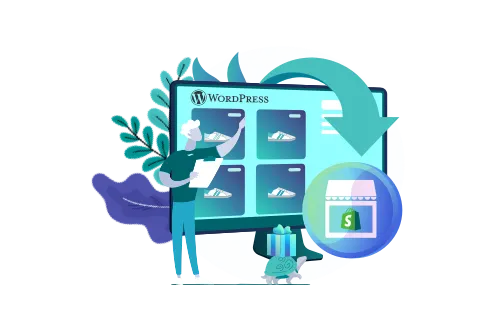Global eCommerce sales are to surpass $8 trillion by 2026. Isn’t that a hint to launch your online store? While jumping onto that bandwagon sounds attractive, you might face a dilemma: choosing between Shopify and WooCommerce.
So which eCommerce platform is best to power your online store? We will compare WooCommerce and Shopify in this blog. So keep reading to learn everything you need. We’ve prepared a comprehensive guide comparing Shopify vs WooCommerce for you.
Discover the core differences between WooCommerce and Shopify, available pricing plans, ease of use, design, plugin, and integration options of Shopify and WooCommerce. Studying all platforms’ characteristics, you’ll have no doubts about which fits your business perfectly.
Let GenovaWebArt assist you in this process, drawing on our expertise in eCommerce. Notably, we’ll leverage our ten-year experience in Shopify design and development to share practical insights with you.
Shopify vs WooCommerce: A Brief Comparison Table
Let’s start digging into the differences between Shopify and WooCommerce. We prepared a quick comparison table outlining the core platforms’ features and their description.
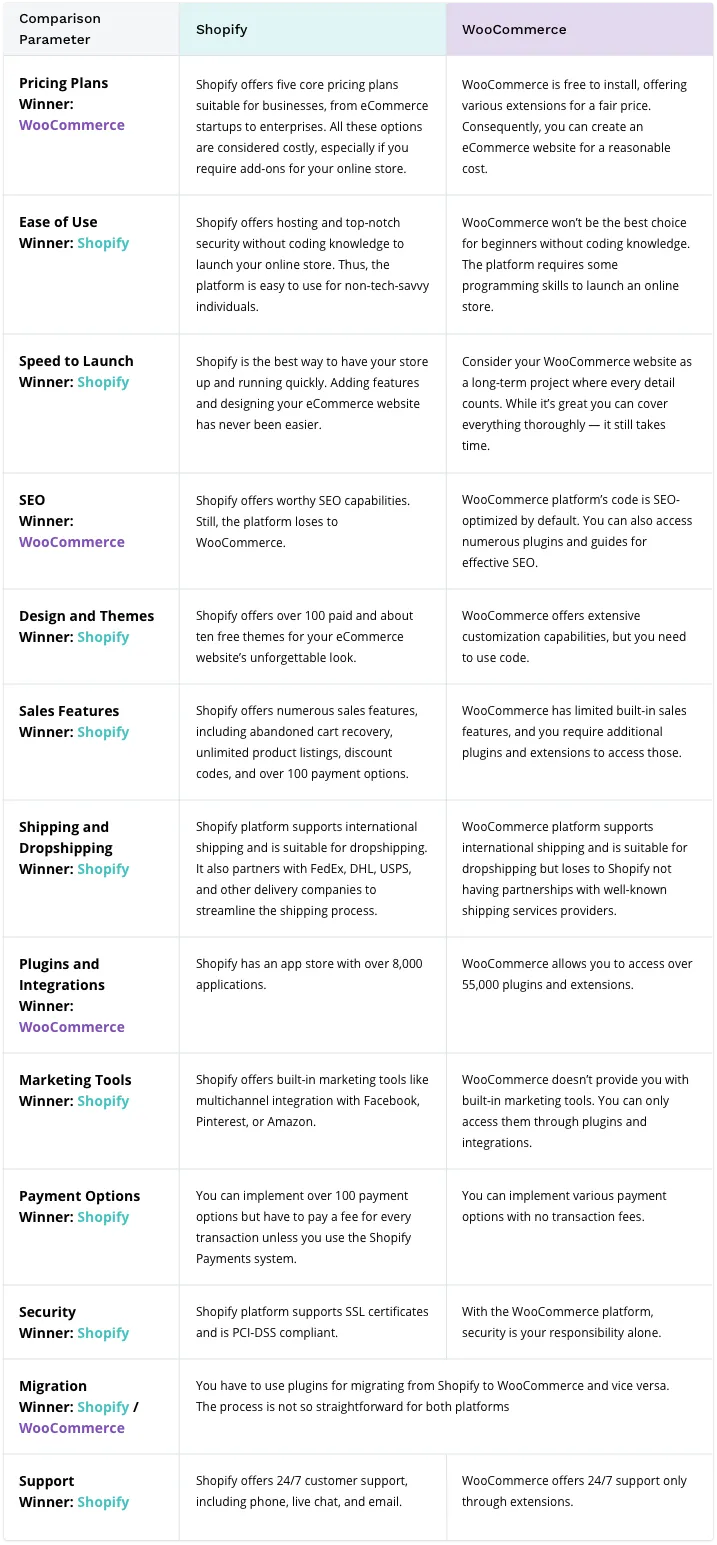
All in all, Shopify has the upper hand in many ways. While this platform may seem quite expensive to some, these costs are fully justified considering numerous built-in capabilities. If your business needs a more low-cost solution, then WooCommerce is also a good option.
WooCommerce vs Shopify: Market Share and Statistics
Let’s now handle a WooCommerce vs. Shopify market share in numbers. This way, you’ll get a deeper look into the prospects of each of these eCommerce platforms.
As the stats from BuiltWith suggest, Shopify has a 25% market share among all eCommerce platforms in the US. WooCommerce is not far behind with 17%.
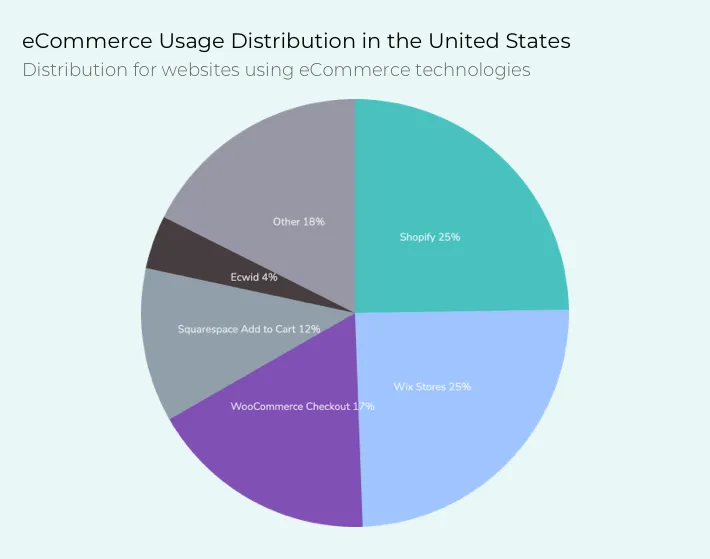
On a global scale, Shopify slightly surpasses WooCommerce. Its market share is 22%, compared to 19% for the WooCommerce platform.
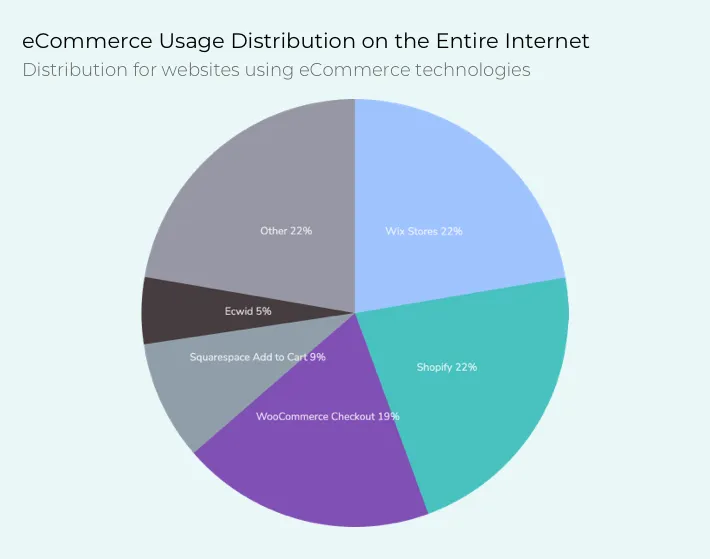
Google Trends is a decent indicator of the company’s popularity. So which eCommerce platform is more popular? Look what we found out:
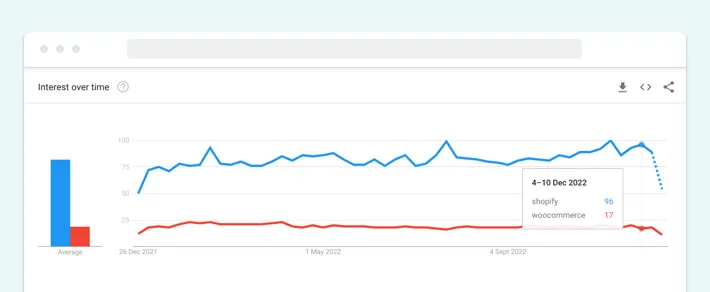
As you can see, Shopify is far more common than WooCommerce. While both platforms are viable solutions for running an online store, let’s discover how many eCommerce websites use them precisely.
Following BuiltWith data, the number of live eCommerce websites is as follows:
- On Shopify — almost 4.2 million online stores in 2022
- On WooCommerce — about 6.6 million online stores in 2022
Although there are fewer stores on Shopify than on WooCommerce, the platform shows a significant gross merchandise volume (GMV). In the third quarter of 2022 alone, Shopify generated $47 billion.
So let’s assume that Shopify is better than WooCommerce. It rapidly grows in popularity, assists in business profitability, and offers extensive functionality. Nevertheless, let’s take a deeper look at these platforms so you can make the right choice.
Shopify or WooCommerce: A Detailed Comparison
Remember today’s comparison table? We’ll elaborate on each point to help you choose between WooCommerce vs Shopify.
1. Pricing Plans
Let’s start with Woocommerce vs Shopify pricing comparison.
Shopify offers several monthly subscription plans where you get a convenient eCommerce store builder with numerous features. Here are the main pricing options:
- Shopify Starter. This option allows you to sell online through social media and messaging applications for $5 per month.
- Shopify Basic. This pricing plan includes an eCommerce store builder with payment, shipping, and basic reporting features for $24 per month.
- Shopify. This option allows you to start selling online by leveraging the professional reports feature and connecting up to five staff accounts for $69 per month.
- Shopify Advanced. This pricing plan helps businesses scale by offering advanced reports functionality, up to 15 staff accounts, and up to 8 inventory locations for $299 per month.
- Shopify Plus. This option is an enterprise-level solution that combines all capabilities from other pricing plans while offering way more. Access the lowest transaction fees, up to 20 inventory locations, and unlimited staff accounts for $2,000 monthly.
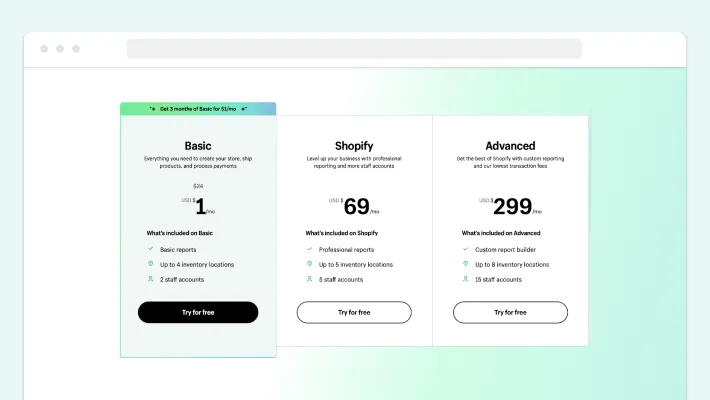
WooCommerce, on the other hand, is an open-source WordPress-based solution. Which means it’s completely free. Yet, you can expect to pay about $12 annually for a domain name and about $20 monthly for hosting. Plus, be ready to spend on extensions and plugins to run your online store.
2. Ease of Use
As for ease of use, Shopify excels in it. It’s an intuitive platform where you can build and design your online store without coding knowledge effortlessly.
To develop a website on Shopify, you only need to create an account, choose a pricing plan, and follow the set-up guidelines.
WooCommerce, in turn, is a platform that requires technical savvy. To create an online store, you need to get a WordPress domain name, take care of hosting, install WordPress, and only after that install the WooCommerce plugin that you’ll work with further.
3. Time to Launch
Consequently, if a Shopify platform is easier to use than WooCommerce, you can launch your online store much quicker. Shopify has numerous built-in features and themes to power your website design. For example, you can check out Nordic-inspired ecommerce options. You can start selling immediately after adding your products to the Shopify store.
It won’t be that fast with WooCommerce, though. Here, you have to take care of plugins and extensions necessary for your online store’s smooth operation.
4. WooCommerce vs. Shopify SEO
Search engine optimization (SEO) is how most customers reach your store. Let’s see what Shopify and WooCommerce offer.
As you already know, WooCommerce is powered by WordPress. The latter is a blogging platform that takes care of SEO capabilities by default. Here, you can adjust body content, add URL redirections, alt tags, meta titles, and descriptions, and use other means to optimize your store for search engines.
On the other hand, Shopify is a bit limited in SEO capabilities. You cannot fully adjust product page URLs due to Shopify’s rigid URL structure. Yet, you can still use other available means for search engine optimization.
5. Design and Themes
Both Shopify and WooCommerce offer numerous themes and templates for your online store.
Comparing these platforms, Shopify provides more than 100 paid and about 15 free themes. All design templates are polished and follow the latest trends in the eCommerce industry. You can also optionally customize themes using code.
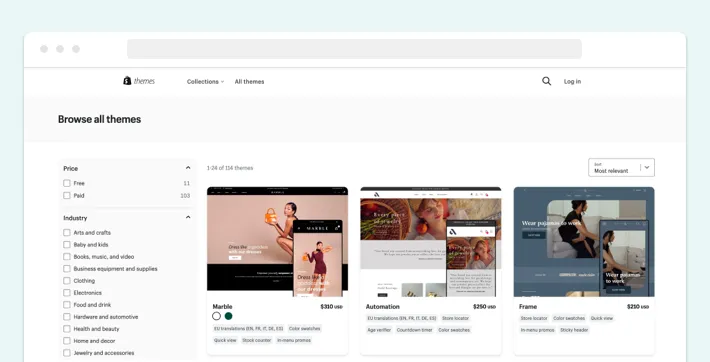
WooCommerce offers more than 60 themes for your eCommerce store. Along with this, you get a high level of customization. Yet, customizing the themes is rather a necessity, as not all of them are up to the highest standards.
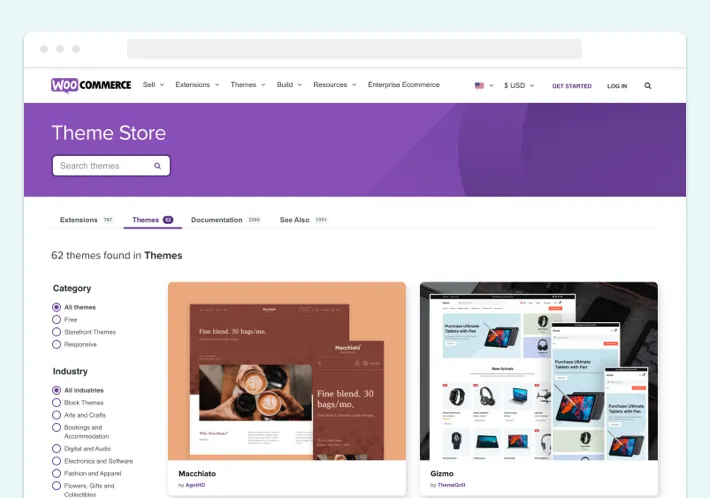
6. Sales Features
Building your online store is one thing, but making your first sales is quite another.
Shopify and WooCommerce have sales features, but the former offers a more extensive range.
For example, Shopify has such functionality as multi-channel sales. You can sell through Facebook, Instagram, eBay, and Amazon in addition to your online store. Plus, you can benefit from the abandoned cart recovery feature prompting your buyers to complete their orders, discount codes to tempt your customers for more purchases, and unlimited product listings.
WooCommerce, in turn, provides such sales features as a built-in blog, one-click refunds, and the ability to embed products on more pages than in Shopify.
7. Shipping and Dropshipping
When it comes to shipping, making it a seamless process is a must. WooCommerce and Shopify have well-established shipping, plus they ship internationally and offer a free delivery option.
Both platforms work well for a dropshipping model, which involves selling products without keeping them in your warehouse.
Yet, Shopify excels in shipping. The platform partners with Canada Post, FedEx, UPS, DHL, and USPS, thus, providing more delivery options to customers.
8. Plugins and Integrations
Undoubtedly, WooCommerce is the king of plugins and integrations. It’s the essence of this platform. If you want a decent eCommerce store, be so kind as to install some extensions. And there are many, many of them.
WooCommerce is open-source, which means anyone can use its code and create some add-ons. Thus, you can choose from over 55,000 plugins and integrations.
Speaking of Shopify, the platform offers over 8,000 paid and free applications to enhance your online store. You can search for Shopify apps in different categories for various purposes, such as store design, order processing, marketing, or sales.
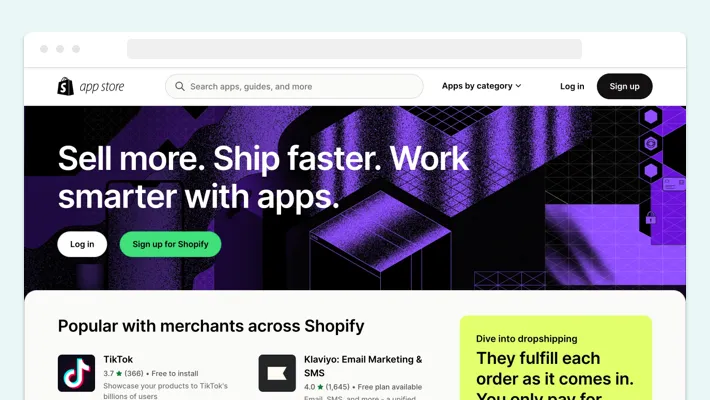
9. Marketing Tools
Shopify is a winner in terms of marketing options. Use email marketing capabilities to reach your customers anytime. Spread your campaigns on social media, including Facebook, Instagram, and Pinterest. Show your ads on Amazon and eBay to attract even more customers.
What about marketing on WooCommerce? The platform hugely relies on plugins in this regard. Thus, you have to take care of extensions to streamline your marketing process.
10. Payment Options
Shopify is better in terms of payment options. And here’s why. It has about 100 built-in payment processors that ensure increased customer convenience.
Yet, the platform charges significant commissions depending on your pricing plan. You can lose %5, %2, %1, %0.5, or %0.15 for every transaction made according to the subscription options mentioned above. The only exception is to use Shopify Payments — the platform’s native payment gateway.
WooCommerce only has built-in Stripe and PayPal. You have to take care of other payment gateways yourself. But the platform has no transaction fees for third-party payment gateways, which is a significant benefit.
11. Security
Let’s now discuss the security features that Shopify and WooCommerce provide.
Shopify has a built-in Secure Sockets Layer (SSL) certificate. It’s responsible for data safety and protects from breaches. Having that feature means:
- Safe payment processing
- Customer data protection
WooCommerce, on the other hand, doesn’t feature this functionality. If you want to protect your store, you should do that yourself. For example, you can get an SSL certificate as part of your hosting plan.
Shopify’s other advantage is that the platform complies with the Payment Card Industry Data Security Standard (PCI-DSS). You can make your WooCommerce store compliant, too, again, manually.
12. Migration
Migration from one platform to another is a challenging process. You risk losing data, harming the customer experience, or missing your orders.
Why migrate to Shopify? Shopify is a powerful and easy-to-use ecommerce platform that can help you grow your business. With Shopify, you can create a beautiful and professional online store, manage your inventory and orders, and accept payments from customers all over the world.
In this regard, we cannot name which platform is better or easier to migrate. Shopify and WooCommerce alike require particular migration plugins to facilitate this process.
Read Also: Shopify Online Store 2.0 Migration
13. Support
Shopify is known for its top-notch customer support features. First of all, it is 24/7 communication with your customers. The second is the possibility of support via phone, live chat, and email. The platform also has an extensive FAQ section, where you can find a comprehensive answer to any question without even contacting the support service.
WooCommerce, as an open-source platform, does not offer customer support by default. To do this, you need to partner with the support service provider. One of the most common options is Bluehost. Once the cooperation is established, you’ll have 24/7 support capabilities via phone, live chat, and email.
GenovaWebArt Is Ready to Become Your Reliable Shopify Partner
GenovaWebArt is a certified Shopify expert. We’ve been developing Shopify stores since 2012, and we’ll help you enter 2023 with a brand-new digital eCommerce solution.
To create robust and modern online stores, we offer dedicated teams of experienced specialists:
- Designers
- Frontend developers
- Backend developers
- Business analysts
- Project managers
Our core Shopify-related services include:
- Shopify theme development and customization
- Shopify app development
- Shopify design
- Shopify store development from scratch
- Shopify migration
- And more
What does cooperation with us mean for store owners? You get excellent communication, profound experience in the industry, official Shopify certification, and reasonable costs. Our team will help your business grow, leveraging the latest innovations and insights.
We have helped our clients launch over 200 profitable and successful eCommerce stores. You can see it for yourself by studying our portfolio. Here are some of our best cases:
Kit and Kin

Kit & Kin is an online store that sells childcare products and nappies. The owner, Spice Girl Emma Bunton, wanted to supply goods that are safe for children and do not harm the environment. That’s how this brand appeared.
Our team helped this online store migrate to Shopify Plus, and we are currently maintaining this eCommerce website.
Ten Thousand

Ten Thousand is another successful store GenovaWebArt has developed. It’s a sportswear brand from New York that encourages continuous self-improvement.
Our team built a scalable and efficient online store and implemented a minimalistic and clean design. Now, we provide ongoing support to this eCommerce website.
Winky Lux

Winky Lux is a beauty brand from the US. Aiming to make statements and leave unforgettable impressions on customers, our client approached us for Shopify store development.
We build a performant website with a playful and colorful design, reflecting the brand vision. Our team also handles this online store maintenance.
Early Rider
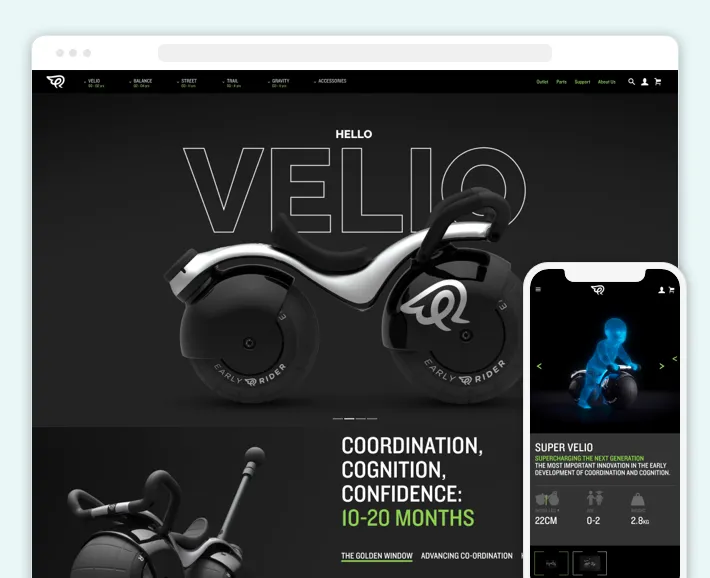
Early Rider is a brand of bicycles for kids and teenagers from the UK. The company aims to redefine the production of children’s bikes and successfully realizes this goal.
The GenovaWebArt team had a long list of tasks for this project. We provided design services on the Shopify Plus platform. Furthermore, we developed this eCommerce website from scratch. Currently, our experts are providing ongoing support for the Early Rider online store.
These are just a few cases from our portfolio. Yet, we constantly deliver something new to the eCommerce industry. We work with online stores of various niches and are ready to implement any of your ideas.
Summary
So, what’s your choice: Shopify or WooCommerce? Check out the features and costs of all these platforms and you will select the most viable solution for your business.
While Shopify is growing in popularity and offers numerous built-in features and an easy setup process, WooCommerce can also be a worthy option for building your online store. When choosing a platform, look at your financial capabilities, functional requirements, and timelines.
Our suggestion is to opt for Shopify. You may say it’s costly, but we’re quick to deny this statement. The price is justified, considering that you won’t have to worry about numerous add-ons like in WooCommerce. Shopify is also about launching your store faster and generating your first sales immediately.
Therefore, if you choose Shopify development, GenovaWebArt will gladly help you with this. We have a decade of experience working with the Shopify platform and several hundred successful projects. So, do not hesitate and contact our experts.
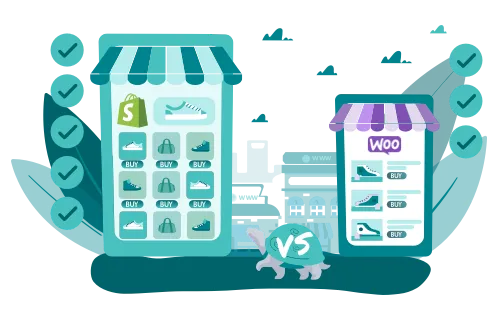


![8 Success Stories of Migrating to Shopify [Real Cases] - GenovaWebArt blog article, banner image 8 Success Stories of Migrating to Shopify [Real Cases] - GenovaWebArt blog article, banner image](https://genovawebart.com/hubfs/img/webp/hero-banner-blog-article-success-stories-of-migrating-to-shopify.webp)

